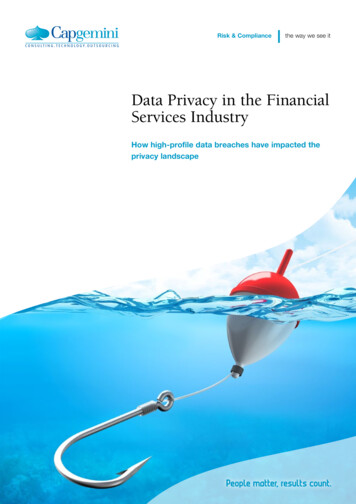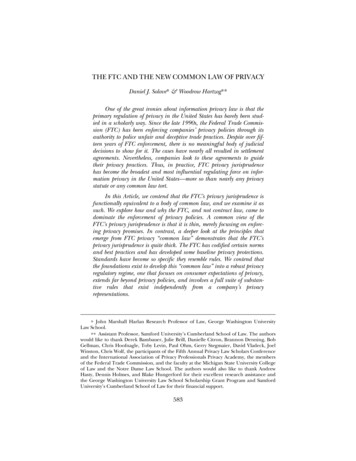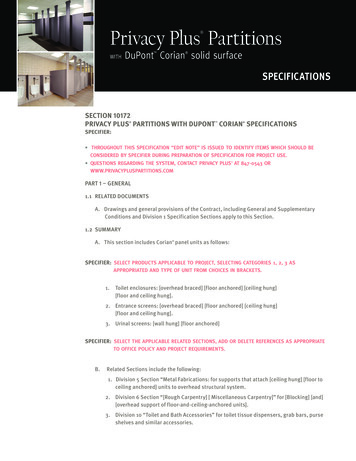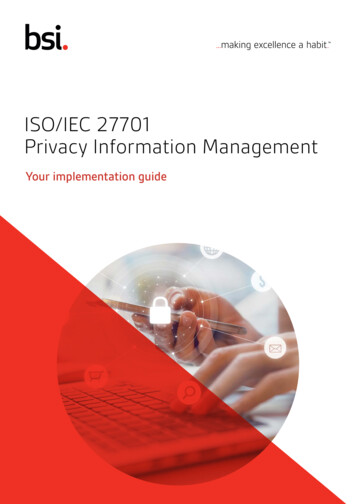
Transcription
Risk & Compliancethe way we see itData Privacy in the FinancialServices IndustryHow high-profile data breaches have impacted theprivacy landscape
Contents1 Overview32 Data Privacy: An Industry Perspective42.1 Data Privacy and its Importance in the Financial Services Industry3 Securing Data and Managing Breaches in theFinancial Services Industry63.1 A Look at High-Profile Data Breaches63.2 A Brief Overview of Privacy Regulations across the Globe73.3 Cost Implications of Data Breaches83.4 Challenges to Data Breach Prevention in an Organizational Setup4 Emerging Global Data Privacy Trends2510114.1 Data Breach Evolution114.2 Regulatory Focus124.3 Technological Evolution135 Data Privacy Recommendations and Solutions forFinancial Services Institutions146 Conclusion15Appendix A: Managing Data Privacy in a Cloud Environment16Appendix B: Managing Data Privacy in an Offshore Environment17References19
the way we see it1 OverviewDivulging personally identifiable information during a business transaction hasbecome a commonplace occurrence for most individuals. This activity can spanfrom sharing of bank account numbers, loan account numbers, and credit/debitcard numbers, to providing non-financial personally identifiable information suchas name, social security number, driver’s license number, address, and e-mailaddress. In short, there is a deluge of personally identifiable information thatbanking, capital markets, and insurance industries deal with and possess as a partof their day to day business.Due to the rising threat of data breaches, identity theft, and associated fraudacross industries, companies are increasingly focusing on enhancing data privacyprograms. The problem of data breaches is a concern across all industries; howeverthe financial services industry is a primary target of fraudsters due to the inherentvalue of the underlying data.This paper discusses the importance of data privacy from the perspective of thefinancial services industry, with an emphasis on the challenges firms face in dayto-day business operations. It also analyzes the role that government organizationsacross the globe are playing in formulating privacy laws and overseeing compliance.Finally, we analyze the steps financial services firms need to take to better protectagainst data breach incidents through the design of proactive data privacy programs.Data Privacy in the Financial Services Industry3
2 Data Privacy: AnIndustry PerspectiveMaintaining the privacy of confidential customer information has become essentialfor any firm which collects or stores personally identifiable data. Such informationmay be general yet sensitive such as names, addresses, and social security numbers;or it can be crucial and financially sensitive data such as credit card, debit card orbank account numbers.As financial servicesinstitutions are the richestsources of personallyidentifiable information—bothgeneral and financial —theyare primary breach targetsand need a comprehensivedata privacy strategy.The financial services industry operates and deals with a significant amount ofconfidential client and customer data for daily business transactions. Due to theperceived value of this data, the financial services industry is one of the primarytargets for data breaches.Exhibit 1: Industry Groups Represented by Breach Events (%), 2010Healthcare 1%Business Services 1%Tech Services 2%Manufacturing 2%Government 4%Media 1%Transportation 1%Others e: Capgemini Analysis, 2011; 2011 Data Breach Investigations Report, VerizonHospitality, retail, and financial services have been among the industry verticalsthat were most affected by data breach events in 2010. Collectively these threeverticals accounted for around 87% of data breach events recorded, with financialservices accounting for almost 22% of total breach cases reported across industriesin 20101. On a positive note for the financial services industry, this 22%represents a drop from 33% in 2009. The 2010 drop is likely due to recent arrestsand prosecutions following large scale intrusions in the financial services industry,which is also leading to increased focus on less reactive targets such as the retailand hospitality industries.142011 Data Breach Investigations Report, Verizon
the way we see itAnother way to measure breaches is the number of records that were compromised.In 2010, approximately 35% of the total records compromised came from financialservices. Even based on this measure, 2010 has been a relatively good year for thefinancial services industry since traditional historical average has been 90% or more.This decrease reflects the lack of large-scale mega breaches in the financial servicesspace in 2010.The financial servicesindustry is one of the primarydata breach targets due tothe perceived value of theunderlying data.2.1. Data Privacy and its Importance in the Financial Services IndustryThe operational structure of financial services institutions requires them to havemore stringent data security standards as compared to those operating in otherindustries. On a regular basis, financial service firms deal with large amountsof personal and confidential customer information including bank accountinformation, debit or credit card data and other business confidential customer data.Data privacy regulations and the potential reputational risks associated with breachevents make having a strong data privacy policy in place even more important.The success or failure of a financial service firm can depend on how it balances theuse of confidential customer information while maintaining privacy. To capitalizeon emerging growth opportunities, financial firms need to be flexible in sharingconfidential customer data—whether across different departments, affiliatedpartners, or non-affiliated third parties such as technology or outsourcing firms—while complying with regulations and protecting the company’s reputation. Thekey lies in this delicate balance between data sharing flexibility and maintainingdata privacy.Data Privacy in the Financial Services Industry5
3 Securing Data andManaging Breaches in theFinancial Services Industry3.1. A Look at High-Profile Data BreachesA quick glance through some of the most high profile data breaches affecting U.S.customers highlights that six of the top ten data breach events that have occurredsince 2007 were at financial service firms, though the number of breaches in thefinancial services firms has decreased in 2010 and 2011.Exhibit 2: Top Ten Data Breaches across Industries Affecting U.S. Consumers(2007-2011)Six of the top ten databreach events that haveoccurred since 2007 wereat financial service firmsDateReportedBreach eventIndustryCompromisedRecords (millions)Jan 2009Heartland Payment SystemsFinancial Services130.0Jan 2007TJ Stores (TJX)*Retail/Merchant100.0Oct 2009U.S. Military VeteransGovernment76.0Aug 2008Countrywide Financial Corp.Financial Services17.0Mar 2008Bank of New York MellonFinancial Services12.5Apr 2011Sony, PlayStation Network (PSN), SonyOnline Entertainment (SOE)Retail/Merchant12.0Jul 2007Fidelity National Information Services/Certegy Check Services Inc.Financial Services8.5Jan 2009TD Ameritrade Holding Corp.Financial Services6.3Sep 2011Tricare Management Activity, SAICOther5.2Jan 2009CheckFree Corp.Financial Services5.0* Includes TJMaxx, Marshalls and Winners in U.S., Puerto Rico, Canada, U.K. and IrelandSource: Capgemini Analysis, 2011; Chronology of Data Breaches, www.privacyrights.orgWhile 2010 was relatively mild in terms of records breached, 2011 has been notablefor a few high profile data breaches, notably the Sony PlayStation network breachwhich affected over 100 million customers globally. Additionally, the financialservices industry witnessed data breaches involving large global firms such asCitigroup and Bank of America. In June 2011, Citigroup U.S. reported that hackerswere able to gain unauthorized access to personally identifiable information suchas customer names, account numbers, and contact information of around 360,0002customers . Citigroup Japan suffered a similar breach affecting around 92,4003customers . Bank of America suffered a massive insider breach in May 2011, whichended up costing the firm around US 10mn4.2346Security breach: Citigroup says 360,000 accounts hacked, Hindustan Times, June 16, 2011Citigroup data breach hits 90,000 in Japan, Japan Today, August 6, 2011Insider data theft costs Bank of America 10 million, Computer World, May 25, 2011
the way we see itThese high profile corporate breaches have highlighted the difficulties faced byeven the largest global businesses to consistently protect their digital assets. Despitehaving robust data privacy programs and data security systems in place, firms arestill vulnerable to fraud through exploring loopholes in existing data protectionsystems and practices.3.2. A Brief Overview of Privacy Regulations across the GlobeMaintaining privacy of data is a primary concerns for companies and governmentsacross the globe. Most countries have privacy laws and regulations intended toprotect personal and sensitive customer data from misuse. These laws set standardsfor companies in terms of how they use, store, and process such data. Countriessuch as the U.S. have passed regulations mandating the client notification of databreaches as soon as a breach occurs.Data privacy laws are present in almost all major countries across the world.While they all revolve around data security, accountability, access, data integrity,consent, disclosure, and notice, the stringency levels of these laws and theirenforcement differ.The following exhibit categorizes major countries based on the level of stringencyin their set privacy regulations and enforcement. Germany and Argentina havethe most restrictive laws and strictly prohibit data transfers to countries withoutadequate data protection regulations. Most other Western European countries fall inthe restrictive category.Exhibit 3: Guide to Region and Country Specific RegulationsEU Data ProtectionDirective and MemberStates, Safe HarborPrinciples (EU)Act on Promotionof Information andCommunications NetworkUtilization and DataProtection (South Korea)UK DataProtectionAct (UK)HIPAA, GLBASafeguards Rule,COPPA GLBA ACTand FACTA (US)Personal InformationProtection andElectronic Data Act(PIPEDA - Canada)Personal DataPrivacy Ordinance(Hong Kong)IT Rules2011 (India)Most RestrictiveRestrictiveLaw for theProtection ofPrivate Life(Chile)Some RestrictionsMinimal RestrictionsPending LegislationNo Legislation orNo informationPersonal DataProtection Law,Confidentiality ofInformation Law(Argentina)ElectronicCommunicationsand TransactionsAct (South Africa)Federal PrivacyAmendment Bill StatePrivacy Bills, Newemail spam and privacyregulations (Australia)Personal InformationProtection Act, METIGuidelines (Japan)Data PrivacyLaw proposedby ITECC(Philippines)Privacy Act(New Zealand)Note: Country boundaries on diagram are approximate and representative only.Source: Capgemini Analysis, 2011; Forrester Research, 2010; International Privacy LawsData Privacy in the Financial Services Industry7
Undoubtedly, the changing technological landscape has had a major role to playin the rapidly evolving privacy environment. Various countries that have relativelyweaker privacy legislation are now updating their privacy laws to be betterpositioned for the technological advancements.The essence of the evolving privacy laws is on the protection and maintenance ofcustomer’s personal information. However, the stringent nature of these privacylaws and regulations can pose business challenges for firms that have centralizedoperations with a presence in multiple locations as well as firms that work withexternal vendors in offshore locations. For example, the European Union dataprotection directive imposes restrictions on the transfer of all personal informationoutside the EU region. The U.S. on the other hand has no specific laws addressingcross-border flow of data but has various laws which require firms to secure allpersonally identifiable information.“ The ability of bad guys toenter, steal, exit and do it ina way that’s undetectable isrising ”Larry PonemonJune 2011The challenges posed by disparities in market-specific privacy laws standardshave been addressed relatively well, with most governments focusing on theharmonization of privacy laws. India, one of the leading outsourcing serviceproviders to many mature markets, has recently developed a comprehensive set ofdata privacy rules under new legislation. This legislation, termed the InformationTechnology Rules 2011, applies to all companies including back office and thirdparty outsourcing firms in order to strengthen data privacy laws in the country.Mexico, another upcoming outsourcing destination, joined 50 other countries inadopting broad privacy regulations focusing on private sector firms.3.3. Cost Implications of Data BreachesData breaches have become an uncomfortably common feature in today’s businesscontext and quite often make news headlines. The cost of a data attack for anycompany can be huge and has been increasing in recent years.Exhibit 4: Average Data Breach Costs per Record (US ) 2009–2010Average Cost per Data Breach (US 0U.SGermanyFrance2009Australia2010Source: Capgemini Analysis, 2011; 2011 Data Breach Investigations Report, Verizon8U.K.GlobalAverage
the way we see itIn 2010, the average cost of data breach has increased across the globe5 with theU.S. breaches costing around US 214 per record compromised6, and a globalaverage of US 156.Malicious or criminal attacks,third-party mistakes, andloss or theft of data storagedevices like laptops have ledto an increased average costof data breaches in 2010.In fact, data breach costs have shown an increasing trend over the past four years.Malicious/criminal attacks, third-party mistakes, and loss or theft of data storagedevices (such as laptops) have led to an increased average cost of data breaches in2010. The increase has been especially true for firms that have shown an inability toprevent and counter these threats. Additionally, the lack of proper breach responseplans by firms has also been a key driver of rising data breach costs.An analysis of the costs incurred in 2010 reveal that reputational losses, as wellas post-breach response costs, is increasingly becoming one of the primarycomponents of overall data breach costs outside of the U.S. In the U.S., regulatorycompliance is the main driver of data breach mitigation costs.Firms that are subjected to a data breach bear both direct and indirect costs. Breachdetection and escalation costs; costs of notifying affected customers; and otherresponse costs such as setting up a communication platform to help breach victimsare direct costs that can be measured by the labor and money spent on theseactivities. Additionally, firms that are found to have been guilty of breach due tonon-compliance of existing privacy laws and weak data security policies may haveto incur other costs in the form of legal fines.However, there are also indirect costs such as reputational costs which can only bemeasured on an economic estimate of lost business opportunities.Exhibit 5: Cost Implications of Data Breach for Financial Services IndustryNotificationCostsEscalationCostsPost BreachResponse CostsDirect andIndirectImplicationsDetection orDiscovery CostsDirect CostsReputationalLossIndirect CostsSource: Capgemini Analysis, 2011; Annual Study: Global Cost of Data Breach, Ponemon Institute and Symantec, May 201156Data Privacy in the Financial Services Industry2010 Annual Study: Global Cost of a Data Breach, Ponemon Institute, SymantecAverage cost of data breach per person affected9
3.4. Challenges to Data Breach Prevention in an Organizational SetupDue to increasing scrutiny from regulators and the media, financial servicesinstitutions continue to face pressure to maintain high standards of data security.Despite the availabilityof automated data lossprevention solutions,employees still play anintegral part in avoidingdata leaks and handlingsensitive data.10Today, financial firms face the following challenges when addressing privacyconcerns and regulations.Information flexibility. Financial service institutions need to provide dynamicaccess to sensitive customer data to clients, employees, and external partners. Sucha high flow of information exchange can make it difficult to protect data. Proliferation of social media. Social networking sites are being used extensivelyfor purposes such as brand building and establishing relationships with customers.While social media provides a relatively inexpensive method of marketing financialproducts/services and better connecting with the customers, it also provideschallenges in maintaining data security. Sophisticated external hackers. Cyber criminals are increasingly usingsophisticated viruses, malware, and other techniques designed to outsmarttraditional data security technologies. Educating employees in data protection. Despite firms having automated dataloss prevention (DLP) solutions, employees still play an integral part in avoidingdata leaks and handling sensitive data. As a result, it can be a challenge tocontinually educate both new and existing staff about various security issues.
the way we see it4 Emerging Global DataPrivacy TrendsEvolving data breach threats are forcing sweeping regulatory changes. With thehelp of technology, financial service institutions are developing and implementingoperational and procedural changes in order to comply. The framework belowcaptures certain emerging trends in three areas witnessed in the wake of databreaches: Data Breach Evolution, Regulatory Focus, and Technology.Exhibit 6: Emerging Data Privacy TrendsData Breach Evolution Growing data breach risksand malicious insidersGrowing threat of financialmalwares to financialfirmsIncreasing data breachmistakesRegulatory Increasing governmentfocus on law enforcementand breach notificationHarmonization of dataprotection standardsacross regionsOutsourcing destinationsadapting privacy laws tohelp industryTechnology Adoption Increasing use of identityand access managementsolutionsFocus on simplifying dataprotection and controllingcostsUsing smartphones toprovide cyber securitySource: Capgemini Analysis, 2011The economic downturn led toemployee layoffs over the pasttwo or three years resultingin an increasing numberof disgruntled employees,who in turn are susceptibleto stealing or disclosingcustomer information.4.1. Data Breach EvolutionFinancial service firms are now facing data breach risks not just from internal andexternal attacks, but also from unintentional mistakes.Growing data breach risks from malicious insidersThe percentage of data breaches attributable to insiders more than doubled to 46%in 20107. The economic downturn led to employee layoffs over the past two orthree years resulting in an increasing number of disgruntled employees, who inturn are susceptible to stealing or disclosing customer information. In most cases,intentional insider breaches have the potential to cause greater financial losses to afirm than an outside attack as insiders generally tend to have full knowledge aboutwhere important and sensitive data is stored.Growing threat of financial malwaresMalware, or malicious programs designed with the intention of stealing financialdata, have grown rapidly to become a leading cause of breach, especially forsmaller financial firms. Malware aids cyber criminals who use it to efficiently gathersensitive information through the internet.7Data Privacy in the Financial Services Industry2010 Data Breach Investigations Report, Verizon11
The Zeus platform-based Ramnit virus has been one of the recent worms affectingfinancial firms’ data security. OddJob, another relatively recent malware, hasthe ability to hijack customer online banking sessions in real-time by using thecustomer’s session ID tokens. Such new malware highlights the fact that hackersare getting inventive in breaching financial data. In addition, this malware allowshackers to sit at one country and execute fraudulent transactions across the globe.For instance the OddJob malware has been used extensively in Eastern Europe toattack banking customers in various countries including the U.S.The risks of unintentional databreaches due to unforeseenproblems such as lost laptopsor improper data disposalremain quite high.Increasing data breach mistakesWhile the possibility of a data breach from internal and external malicious attacksis often discussed, the risks of unintentional data breaches due to unforeseenproblems such as lost laptops or improper data disposal remain quite high and canhave a significant impact on a company. The challenge that most firms face is thatpeople still do not fully understand the need to safeguard data and the efforts byfirms to train employees do not seem to have yet provided the desired results. Firmsare expected to continue investing time and resources in order to ensure that whatis meant to stay confidential does stay confidential.4.2. Regulatory FocusGlobally, legislation is increasingly focusing on enacting laws that maximize dataprivacy and minimize breach impact on businesses.Increasing government focus on law enforcement and breach notificationRegulators across the world are seeking stricter law enforcement through tougherpenalties on data breach violators. In the European Union, data protectionauthorities can now investigate and prosecute organizations for non-compliance.Several other countries are intensifying their existing law enforcement policies.While the U.S. has been one of the earliest to adopt breach notificationrequirements, other nations are following suit.Harmonization of data protection standards across regionsData protection standards vary across the world with no unified approach, whichcomes at a cost—especially for banks, insurers and capital markets firms whichhave multinational operations and deal with third party vendors such as offshoreoutsourcing partners and local governing bodies. The European commission hasrecently vowed to resolve this issue by cutting down excessively bureaucratic andineffective notification requirements across the region. The European commissionalso plans to establish a voluntary registry for companies in non-EU countries thatagree to abide by the EU data security standards, in a bid to simplify data security.In order to comply with the stringent data security standards set by the EU’s DataProtection Directive, many emerging countries are beginning to adopt these broadprivacy regulations.12
the way we see itTo comply with the stringentdata security standards setby the European Union’sData Protection Directive,many emerging countriesare beginning to adopt thesebroad privacy regulations.Outsourcing destinations adapting privacy laws to help industryTo enhance data security standards and alleviate privacy concerns around foreigncountries, most outsourcing destination countries—including India—have recentlyimplemented new data privacy rules. Originally, proposed privacy regulations set byIndia required firms to obtain the consent of end customers before it could collecttheir personal information. Such regulations, if implemented, would have poseda new set of challenges to the outsourcing business. The Indian government laterclarified that they have exempted outsourcing companies from these regulations inIndia, a move that is expected to minimize any negative effects of the latest privacyregulations on the outsourcing industry.4.3. Technological EvolutionFirms are using technology to enhance data protection and better controlcompliance-related costs.Increasing use of identity and access management solutionsThe financial service industry is increasingly investing in identity management andcontrol tools to limit access to critical information and keep track of who has accessto what information. Identity and access management tools, which traditionallyperformed the function of a gatekeeper, have evolved with technology and are nowbeing used to perform advanced functions such as: defining access levels; trackingof events with regards to when a particular breach has taken place; locating wherethe breach happened; and identifying the time of the breach occurrence.Focus on simplifying data protection and controlling costsDriven by the advent of new computing models, the deluge of backup applications,and the multitude of network choices, the complexity of data protection hasincreased for all organizations. Security officers are expected to look for storagepooling in order to meet various data protection requirements, including but notlimited to classifying data and policy management.Using smartphones to provide cyber securityMajor banks such as Citibank, Bank of America, and Chase currently send texts tocustomers on their mobile phones to alert them about large purchases or unusualaccount activity. Banks are now looking to convert their customers’ smartphonesinto security tokens in order to provide them with an additional layer of protection,especially for online transactions. To convert these smartphones into securitytokens, banks just need to install software that will enable these smartphones togenerate new passwords frequently, saving the cost of providing customers with aseparate security key fob.Data Privacy in the Financial Services Industry13
5 Data PrivacyRecommendations andSolutions for FinancialServices InstitutionsSecuring data in the current information age is one of the biggest challenges facedby firms. Various data breaches reported by companies in the recent past highlightthat a data breach can take multiple forms and that there is no single solution tostop these breaches. Data breaches can be caused by variety of reasons, rangingfrom an improper data disposal processes to weak data security practices.Financial service firms needto be flexible in using andsharing non-public confidentialcustomer data, which makesthem vulnerable to data breachrisks at various stages of theirbusiness process.A comprehensive data privacy program is essential in an organizational setup dueto the omnipresent nature of the data breach risks. The essence of a data privacyprogram is risk reduction through a well-planned and properly implementedprivacy policy. We have detailed a few steps to effectively implement acomprehensive data privacy program in an organizational setup:1. Identifying and classifying sensitive information2. Scaling down the accessibility of information through data monitoring as well asidentity and access management solutions3. Safeguarding information through a variety of data security controls andadvanced technologies such as encryption, tokenization, and data masking4. Having a clear data disposal policy in place5. Planning for a security breach by having a contingency breach response planThe recent spate of data breaches have highlighted that breaches are ubiquitous,however organizations need to understand that both internal and external breachescan be preventable. Listed below are recommendations for financial services firms toenhance data privacy for their digital assets.Centrally manage endpoint solutions. Firms can lower or stop externalincursion by better managing endpoint solutions for security patch deployment,information access, and encryption capabilities. Align global security with real-time threat alerts. Use a security informationand event management system that can identify known threats and problematicsites and block them immediately. Proactively protect data. Implement a unified data protection policy includingindividual systems, servers, networks, and endpoints which, with the aid ofappropriate DLP solutions, can also stop data extraction in case of an externalbreach. Implement automated compliance controls. Ensure that IT compliance controlsconform to industry standards such as Payment Card Industry Data SecurityStandards and the Gramm-Leach Bliley Act and ensure maximum data protection. Integrate security solutions with regular operations. Create an operationalmodel that is content-wise, workflow-driven, and can identify as well as cementany gaps in the security process. The cost of a data breach usually far exceeds the investments in such proactiveprotection steps.14
the way we see it7 ConclusionFinancial service institutions have traditionally considered data privacy as acompliance cost. However going beyond compliance costs, reputational damagesdue to data breaches that expose confidential customer information can costfirms significantly. It is therefore imperative for financial services firms to havea comprehensive data privacy program with a combination of policies, accesscontrols, and various DLP technologies that enable them to continuously protectthemselves against emerging threats. While a strong data security managementis crucial in the current business landscape, failures are unavoidable. Therefore,firms also need to have a breach response plan in order to prepare for a breachcontingency. Having contingency plans as well as a proactive data privacy policy,are of key importance for all organizations.The cost implications of a data breach from both monetary and reputationalperspective are increasing exponentially for financial firms. Accordingly, the riskmanagement team of every financial service institute needs to play an active rolein shaping policies regarding data security, in close partnership with their firms’information technology groups.Data Privacy in the Financial Services Industry15
Appendix A: ManagingData Privacy in a CloudEnvironmentPrivacy Landscape in a Cloud EnvironmentThough the financial services industry has generally been an early adopter ofnew technologies, the industry has be
Jan 2009 Heartland Payment Systems Financial Services 130.0 Jan 2007 TJ Stores (TJX)* Retail/Merchant 100.0 Oct 2009 U.S. Military Veterans Government 76.0 Aug 2008 Countrywide Financial Corp. Financial Services 17.0 Mar 2008 Bank of New York Mellon Financial Services 12.5 Apr 2011 Sony, PlayStation Network (PSN), Sony










